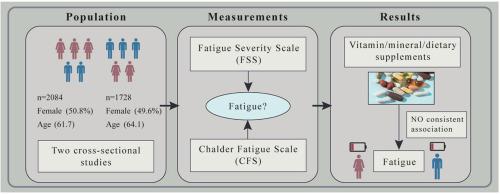Vitamin and mineral supplements: Are they associated with fatigue?
IF 2.9
Q3 NUTRITION & DIETETICS
引用次数: 0
Abstract
Background and aims
Vitamin/mineral supplements (VMS) and vitamin/mineral and/or dietary supplements (VMDS) are commonly consumed, based on the belief of their invigorating properties. Still, the association of VMS/VMDS with fatigue in the general population remains sparse and conclusions are mixed. This study aimed to understand the association between VMS/VMDS and fatigue.
Methods
Two cross-sectional studies (2014–2017 and 2018–2021) conducted on a population-based cohort. Participants were divided into VMS/VMDS users and non-users. Fatigue levels were assessed using the Fatigue Severity Scale (FSS) and the 14-item version of the Chalder Fatigue Scale (CFS).
Results
Overall, 2084 (50.8 % female, 61.7 ± 9.8 years) and 1728 (51.0 % female, 64.1 ± 9.3 years) were included in the first and second surveys, respectively. In the first survey, after multivariable analysis, no association was found between VMS use and FSS: adjusted mean ± sem 3.04 ± 0.13 vs. 2.82 ± 0.03 for users and non-users, respectively, p = 0.083, while users scored higher in the CFS: 6.17 ± 0.22 vs. 5.72 ± 0.06 for users and non-users, respectively, p = 0.048. In the second survey, no association was found between VMS use and FSS (2.83 ± 0.19 vs. 2.84 ± 0.03, p = 0.952) and CFS (5.38 ± 0.33 vs. 5.61 ± 0.06, p = 0.504). In the first survey, VMDS users scored higher in both FSS (3.03 ± 0.06 vs. 2.76 ± 0.04, p < 0.001) and CFS (6.19 ± 0.11 vs. 5.58 ± 0.06, p < 0.001) while no differences were found in the second survey in both FSS (2.93 ± 0.07 vs. 2.81 ± 0.04, p = 0.161) and CFS (5.78 ± 0.12 vs. 5.54 ± 0.07, p = 0.088).
Conclusion
In this population-based cross-sectional study, the authors found no consistent association between VMS consumption and fatigue. Participants taking VMDS tended to present with higher fatigue scores.

维生素和矿物质补充剂:它们与疲劳有关吗?
背景和目的:维生素/矿物质补充剂(VMS)和维生素/矿物质和/或膳食补充剂(VMDS)是人们经常食用的食物,因为人们相信它们具有提神醒脑的功效。然而,在普通人群中,维生素补充剂/矿物质补充剂与疲劳的关系仍然很少,结论也不尽相同。本研究旨在了解VMS/VMDS与疲劳之间的关系:对基于人群的队列进行了两项横断面研究(2014-2017 年和 2018-2021 年)。参与者分为VMS/VMDS使用者和非使用者。使用疲劳严重程度量表(FSS)和14个项目版的查尔德疲劳量表(CFS)评估疲劳程度:第一次和第二次调查分别纳入了 2084 人(50.8% 为女性,61.7±9.8 岁)和 1728 人(49.6% 为女性,64.1±9.3 岁)。在第一次调查中,经过多变量分析后发现,VMS 的使用与 FSS 之间没有关联:调整后的平均值(±sem)分别为 3.04±0.13 vs. 使用者和非使用者为 2.82±0.03,P=0.083;而使用者的 CFS 得分更高:使用者和非使用者分别为 6.17±0.22 vs. 5.72±0.06,P=0.048。在第二次调查中,VMS 的使用与 FSS(2.83±0.19 vs. 2.84±0.03,p=0.952)和 CFS(5.38±0.33 vs. 5.61±0.06,p=0.504)之间没有关联。在第一次调查中,VMDS 使用者在 FSS(3.03±0.06 vs. 2.76±0.04,P
本文章由计算机程序翻译,如有差异,请以英文原文为准。
求助全文
约1分钟内获得全文
求助全文
来源期刊

Clinical nutrition ESPEN
NUTRITION & DIETETICS-
CiteScore
4.90
自引率
3.30%
发文量
512
期刊介绍:
Clinical Nutrition ESPEN is an electronic-only journal and is an official publication of the European Society for Clinical Nutrition and Metabolism (ESPEN). Nutrition and nutritional care have gained wide clinical and scientific interest during the past decades. The increasing knowledge of metabolic disturbances and nutritional assessment in chronic and acute diseases has stimulated rapid advances in design, development and clinical application of nutritional support. The aims of ESPEN are to encourage the rapid diffusion of knowledge and its application in the field of clinical nutrition and metabolism. Published bimonthly, Clinical Nutrition ESPEN focuses on publishing articles on the relationship between nutrition and disease in the setting of basic science and clinical practice. Clinical Nutrition ESPEN is available to all members of ESPEN and to all subscribers of Clinical Nutrition.
 求助内容:
求助内容: 应助结果提醒方式:
应助结果提醒方式:


